
---- News, Views & Information
 |
Amersham
---- News, Views & Information |
Over the years Amersham Hospital has changed a lot.
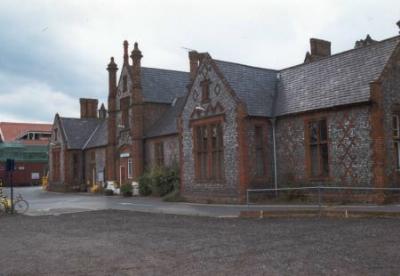 |
| At the end of Whielden Street is
Amersham Hospital. The above picture shows the old hospital
buildings. The old hospital was originally the workhouse. The fine
gothic building was designed by Sir George Gilbert Scott and built
in 1838/9. It was built following the Poor Law Amendment Act of 1834
which obliged parishes to form a "union" to build a workhouse. The
Amersham Union included the parishes of Chesham, Beaconsfield, the
Chalfonts and Penn. Typically, a Union Workhouse was built in the
largest town of the Union. In Amersham's case this should have been
Chesham, but Amersham was chosen. The Union Workhouse replaced the
many work houses around the parishes, with the "inmates" being moved
from their local towns, sometimes leaving them for the first time in
their lives. Owing to the location of the "union" Workhouse,
Whielden Street was for a time known as Union Street. The name
reverted to Whielden Street (named after a previous land owner) in
1930 when Bucks County Council took over the site replacing the
Union. Life in the Union Workhouse was tough, the inmates having to
wear uniforms, work hard and were forced to church on Sundays. Men,
women and children were housed in separate wards. There was also an
infirmary and tramps and vagrants wards. Prior to the building of the workhouse, there had been other smaller workhouses in Amersham. Although now a hospital, it should not be forgotten that until the second World War, Amersham did not have a proper hospital. The workhouse remained until 1930 when it was replaced by The Amersham Public Assistance Institute and St. Mary's Hospital. If people were ill, they were either treated in their homes, sent to a hospital in another town, or if they had a contagious disease they were sent to the "Pest House" half way up Gore Hill. Records date the Pest House from the 17th century. People coming out of London during the plague were sent to the Pest House, along with those who caught the plague in Amersham. Later, it became an isolation unit. It was a fairly small two story building, a bit like a cottage, the walls covered in tar. It became a private house and was demolished in 1964 when Gore Hill was widened. Although people no longer get sent to the Pest House, owing to reorganizations of the N H S services, patients once again have to travel to distant hospitals for many illnesses to be cured. The above picture was taken in 1999 while the hospital was being rebuilt, note the new construction in the background. The old hospital buildings were converted into housing and flats. One of the first changes to the old building has been the reopening of the arch through the front building to the courtyard behind, the new "old" arch is in the centre of the building where the doorway under the white sign is in the above photo. |
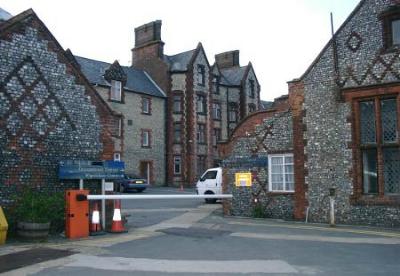 |
| The courtyard of the old workhouse buildings. At one time the buildings at the back contained wards, but over the last 50 years or so have provided accommodation for medical staff, offices, education facilities and in part of the attic the old hospital radio studio. |
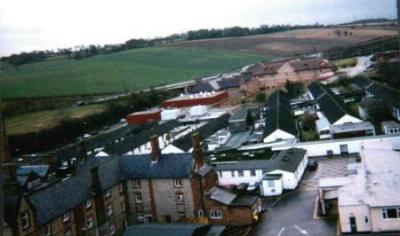 (Picture courtesy of Trevor Johnson) |
| The
new hospital was built on the site of the "temporary" buildings
constructed during World War II. Part of the site was commandeered
in
the War to become an "Emergency Services Hospital" serving the
military
and civilians. It became an over flow hospital of St Mary's
Hospital,
Paddington. "Temporary" buildings were erected to form wards
and
operating theatres in 1939/40. They were built by Canadian Forces
and
these temporary buildings remained in use until the end of the
1990s.
There were 280 beds in the temporary hospital and 138 in the old
work
house part. St. Mary's Hospital in Paddington assisted in the
running
of the hospital. (Thanks to the Amersham
Society for information). The above picture was taken from
the top of the Chenies Nurses Home. The White buildings are the
"temporary buildings". The brick building in the background is the
Haleacre psychiatric unit and dermatology unit which were opened in
the early 1990s as an extension to the hospital. The "red" building
was the new operating theatre block opened in the 1980s, now
demolished. To see the demolition and rebuilding of Amersham Hospital Click Here |
 |
| The "temporary" buildings were erected during the World War II as Amersham Hospital expanded. After the War the buildings continued to be used and were only closed in 1999. At their height there were about 8 wards with operating theatres and associated support facilities. |
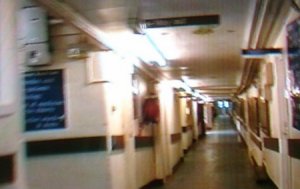 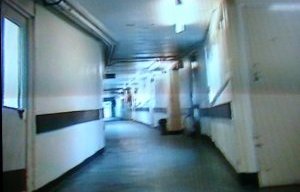 |
| A long "spine" corridor linked all
the buildings / wards. The wards were built off each side of the
corridor and the whole "temporary" hospital was built up the side of
a hill. This meant the "spine" corridor was in fact a very steep
curved passage way - it made riding in a wheelchair or on a theatre
trolley an interesting experience for both patients and those
pushing the trolley or chair!. Ironically, the "temporary" old wards were temporarily replaced by new temporary wards while building works were completed! The temporary new temporary wards have now been demolished along with the operating theatres (opened in the 1980s when some of the World War II buildings were demolished) with the services being transferred to Wycombe Hospital. |
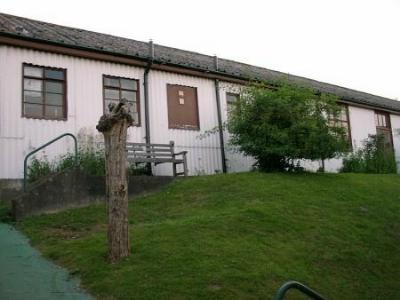 |
| Although the buildings did not look like much from the outside, and in their latter years were not that special inside either, the staff at the hospital made up for this. |
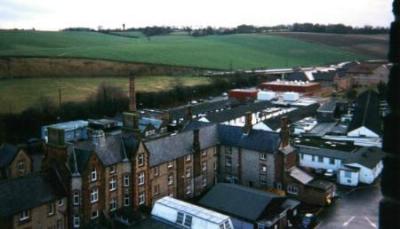 (Picture courtesy of Trevor Johnson) |
| The above picture shows the old hospital buildings with the old laundry at the front, with the white World War II temporary buildings housing A ward and the restaurant. None of the temporary wards are left and the old laundry at the front of the hospital with the large chimney has also vanished. |
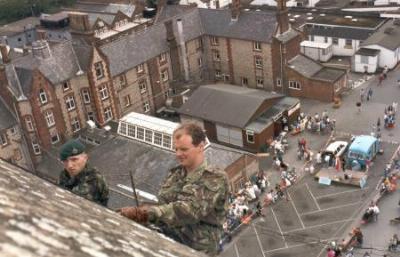 (Picture courtesy of Dick Croxson) |
| During the early 1990s during a hospital open day, the army abseiled down the side of the Chenies Nurses home. Members of the hospital radio station were able to go on the roof and took the above picture. |
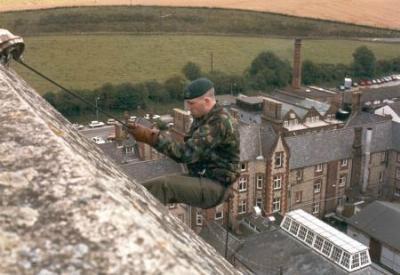 (Picture courtesy of Dick Croxson) |
| Looking down on the old work house building with the laundry at the front of the hospital. |
 |
| The old outlives the new. The rebuilding of Amersham hospital saw the demolition of the ugly 1960s Chenies Nurses home. The old work house buildings which the tower was behind have been converted into housing./ accommodation. |
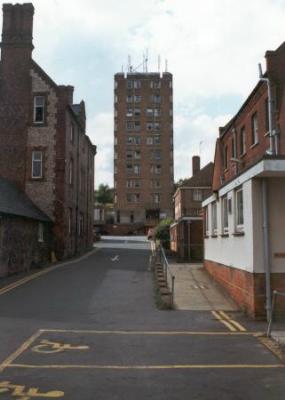 |
| Another view of the nurses home. On the right, now demolished is the old Heberden Unit. The Heberden unit used to be the maternity unit. This unit closed in the 1980s, with people from the Amersham area now having to use Wycombe or Hemel hospitals. As an aside, Amersham at one time had another maternity unit - at Shardeloes. During World War II Shardeloes was used to help mothers from London give birth in an environment away from the hustle and bustle of London. |
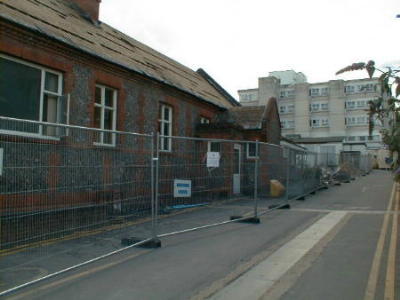 (Picture courtesy of Trevor Johnson) |
| The above picture shows the old out
patients building just before demolition. This building also used to
house the casualty unit. The building in the background was the
Misbourne Unit which housed geriatric wards. This building has also
been demolished. Over the last 40 years Amersham hospital has lost its maternity unit (1980s), casualty / A & E department (1970s) and in the 1990s it lost its childrens and surgical wards. Amersham hospital has changed from a general hospital to a specialist hospital, with all acute services centered at Wycombe. |
To see the demolition and rebuilding of Amersham Hospital
Click Here
To see the new Amersham Hospital Click
Here
This web page and web site has no
connection with Amersham hospital. Do not attempt to contact Amersham
hospital via this web site as we regret we are unable to help. Please
see
Amersham Home Page
This web site is Copyright
and operates a privacy
policy
please also see disclaimer